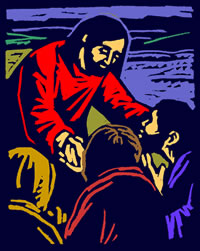
2nd Sunday of Lent Year A
Each year on the second Sunday of Lent, the liturgy’s gospel reading tells of the Transfiguration. This year we hear Matthew’s account. Throughout our long Lenten observance, we are encouraged to keep in mind the triumphant glory of the Saviour that we are preparing to celebrate, and the challenge it brings to us. All three gospels link the Transfiguration with the warning of Jesus, that he was ‘destined to suffer’ in Jerusalem, and that those who are his true followers must ‘take up their cross and follow him’.
What is the basis of this mysterious narrative, that is not easy to relate to the later attitudes displayed by the apostles as the story of the gospels unfolds? It had obvious importance for the Church of the beginnings, because it is given in all three synoptic gospels. Luke associates this experience of the three apostles - who were to witness the agony of Jesus in the garden - with a moment in which Jesus led them in prayer. Perhaps the narrative has its basis in an ecstatic prayer experience. Perhaps the more restrained presentation of Luke, the gentile convert, is significant. Luke avoids reference to a metamorphosis (‘transfiguration’), a phenomenon associated with the gods of the pagan mythology. He merely states that ‘the aspect of Jesus’ face was changed’. No doubt, the early Church saw this narrative as an important expression of their faith in the Saviour - as sharing in the Father’s greatness and glory, even in the obscurity of his earthly life.
Matthew’s recounting of this tradition, with its many references to biblical themes familiar to the Jewish converts of his community, presents the Jesus of the Transfiguration as fulfilling what was prefigured in the history of old Israel: the ‘mountain’ reminds us of the defining moment of the Sinai covenant; ‘Moses and Elijah’, representing the Law and the Prophets, both have close links with Sinai; the ‘cloud’ recalls the ‘shekinah’ cloud that was an expression of Yahweh’s presence during the Exodus; the shining face of Jesus reminds us of the face of Moses when he came down from the mountain; Peter’s reference to the ‘three tents’, or booths, recalls the Jewish feast of Tabernacles, when the people lived in booths celebrating their arrival in the promised land – a celebration of the kingship of Yahweh that came to be filled with messianic expectations. Matthew adds to the words of the Father from the cloud a reference to one of the songs of the Suffering Servant (Is 42:1), bringing us back to the association of the Transfiguration with the warning of Jesus - of the ordeal that lay ahead of him in Jerusalem, and the challenge of discipleship.
The term used by Mark and Matthew for the transformation that took place in Jesus - that we are accustomed to translate, ‘transfiguration’- is also used in the New Testament to describe the spiritual transformation brought by life ‘in Christ’. For the first Christians, it had overtones of the blessings of the final kingdom announced by Jesus. The journey begun so long ago - in the story of Abraham’s heroic response to the call of God, and the promises that accompanied it - has brought God’s people to the moment of fulfilment.
John Thornhill sm

